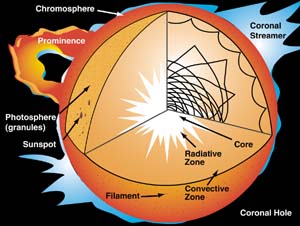chromosphere

The chromosphere is a narrow, irregular region of a star's atmosphere that lies between its photosphere and its corona. The chromosphere of the Sun is the source of many solar phenomena including flares and prominences.
The Sun's chromosphere starts from a temperature of about 6,000 K at the top of the photosphere. At about 500 kilometers above the photosphere, there is a temperature minimum of about 4,300 K and, above this, for about another 2,000 kilometers, an increase in temperature to about 20,000 K. From this point up, to the base of the corona, about 10,000 km above the photosphere, is the transition region in which the temperature climbs swiftly to over one million K. The composition and density of the chromosphere also changes markedly. While the lower 1,500 kilometers or so is more or less continuous, the upper chromosphere features jagged spicules. At the same time, the density drops by a factor of about a million from bottom to top.
The chromosphere ('color sphere') is so-named because when visible immediately before and after a total eclipse, its light is dominated by the red glow of H-alpha. At other times it can be observed using H-alpha and calcium K-line filtergrams and, from space, in ultraviolet emission lines.
Chromospheric network
The chromospheric network is an ever-present network of long thin sinuous chains of tiny low-contrast brighter points called filigree (also found in plages) extending over much of the solar disk in H-alpha. These points, or network elements, often have darker spicules or short fibrils sticking out of, or running over them (part of the fine disk detail known as the dark mottles), making the actual network harder to see. The chromospheric network is formed by magnetic field lines related to supergranulation cells in the photosphere.


